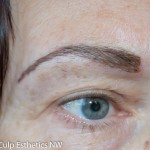Microblading, Tattoos and Permanent Makeup

A recent magazine article opened with this phrase… “Microblading, tattoos and permanent makeup are more popular than ever.” This reflects a new trend I see happening. Re-naming things to gain market share. And actually… it’s just history repeating itself.
A tattoo, by definition, is implanting pigment into the skin in a way it doesn’t exfoliate off as the skin heals. It doesn’t matter what you call it, it’s still a tattoo. Even skin coloration dots used for radiation are a tattoo.
Other names you will hear are:
· embroidery,
· micropigmentation,
· dermal pigmentation,
· feather stroking,
· hair strokes,
· scalp micropigmentation,
· hombre brows,
· 3D brows,
· 3D areola coloration,
· cosmetic tattooing,
· permanent cosmetics/ permanent makeup
· microblading.
Why all the names…

The techniques vary slightly but they are all forms of tattooing used to create the look of makeup. To learn one technique, or perform one technique, limits the ability to meet diverse needs. Think of it this way… one size never fits all.
So why did people coin all these different terms? Marketing. Even just 20 years ago tattooing wasn’t mainstream. “Nice” people didn’t get a tattoo. So they came up with alternative terms to step away from being associated with tattooing.
All that has changed. Now 40% of millennials, 30% of gen-xers, and 13% of the boomers have at least one tattoo. Many have more. The stigma of a tattoo is gone. Alternative terms are used for marketing or to describe a “style” of eyebrow work.
The key difference among tattooing is its purpose, where it’s placed and the type of pigments used.
Artistic tattoos…
Artistic tattooing is decorative in purpose. It’s placed anywhere on the body. That said, most experienced tattooists don’t like to work below the wrist, below the ankle or on the head. They call those areas “trash skin” because they don’t take the color well and it tends to blur quickly.
Their pigments are classical in formula using a full range of colors. They tend to be bright, clear and are formulated to replicate the tones found in nature. Colors will fade over time with exposure to UV. Carbon Blacks can blur and spread into wider lines.
Permanent Makeup…
With permanent makeup, the work is on the face or after cancer on the breast. Its purpose is to create a makeup look or replace missing color. Pigments are formulated to meet this purpose.

They use an iron-oxide black formula to minimize the risk of migration over time. The pigments are creating the look of makeup. They are blends, not color-wheel tones.
Work on the face, it gets regular UV exposure. Traditionally, color re-enhancement is 2-5 years. Microblading techniques for the eyebrows put in less color. They will need re-enhancement every 8-12 months.
Whether you are seeking microblading, tattoos or permanent makeup there is something more important than the name associated with a style of work. That’s the amount of training and experience of the person performing the service.
Traditional tattooists may spend a year, or several, learning their craft. Unfortunately for the consumer, this isn’t true with permanent cosmetics.
Considering microblading, tattoos, and permanent makeup? Do your research…

In most states, the only regulation on tattooing is the minimum age of the client. Some have regulations regarding infection control. But only a very few states have regulations regarding technician education requirements. In most states, it’s legal for someone to offer permanent cosmetics with little to no training.
If you’re a consumer… do your research. Find someone who has had more one or two days of training and can offer you the style of work you are hoping to achieve. Explore your options and feel comfortable with your choice. If you are searching for a technician, visit the Society of Permanent Cosmetic Professionals (SPCP) website. They provide a list of technician members who meet national standards. https://www.spcp.org/thinking-of-getting-a-cosmetic-tattoo/find-a-technician/.
If you’re a technician or wanting to learn this art, invest the time and money to develop your skills. Look for a program that at least meets the SPCP training standards. They recommend all programs, even those teaching only one technique to be at least 100 hours. https://www.spcp.org/information-for-technicians/spcp-guidelines/.
Your reputation and your client’s face are in your hands.

